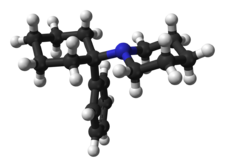
Back فينسيكليدين Arabic فئنسیکلیدین AZB Angel Dust BAR Pols d'àngel Catalan Fencyklidin Czech Phencyclidin Danish Phencyclidin German Φαινκυκλιδίνη Greek Fenciklidino Esperanto Fenciclidina Spanish
Phencyclidine or phenylcyclohexyl piperidine (PCP), also known in its use as a street drug as angel dust among other names, is a dissociative anesthetic mainly used recreationally for its significant mind-altering effects.[1][5] PCP may cause hallucinations, distorted perceptions of sounds, and violent behavior.[5][8][9] As a recreational drug, it is typically smoked, but may be taken by mouth, snorted, or injected.[5][6][8] It may also be mixed with cannabis or tobacco.[1][5]
Adverse effects may include seizures, coma, addiction, and an increased risk of suicide.[8] Flashbacks may occur despite stopping usage.[9] Chemically, PCP is a member of the arylcyclohexylamine class, and pharmacologically, it is a dissociative anesthetic.[5][10][11] PCP works primarily as an NMDA receptor antagonist.[10]
PCP is most commonly used in the United States.[12] While usage peaked in the US in the 1970s,[13] between 2005 and 2011 an increase in visits to emergency departments as a result of the drug occurred.[8] As of 2017 in the United States, about 1% of people in 12th grade reported using PCP in the prior year while 2.9% of those over the age of 25 reported using it at some point in their lives.[14]
- ^ a b c "PCP Fast Facts". National Drug Intelligence Center. 2003. Archived from the original on 14 August 2021. Retrieved 19 February 2018.
- ^ Stobo JD, Traill TA, Hellmann DB, Ladenson PW, Petty BG (1996). The Principles and Practice of Medicine. McGraw Hill Professional. p. 933. ISBN 9780071383653.
high abuse liability
- ^ Cite error: The named reference
NHM-PCP and ketaminewas invoked but never defined (see the help page). - ^ Stobo JD, Traill TA, Hellmann DB, Ladenson PW, Petty BG (1996). The Principles and Practice of Medicine. McGraw Hill Professional. p. 933. ISBN 9780071383653.
high abuse liability
- ^ a b c d e f g Giannini AJ (1998). "Chapter 35: Phencyclidine". In Tarter RE, Ammerman R, Ott PJ (eds.). Handbook of Substance Abuse: Neurobehavioral Pharmacology. New York: Plenum Publishing Corporation. pp. 579–587. ISBN 978-1-4757-2913-9.
- ^ a b "NIDA InfoFacts: Hallucinogens – LSD, Peyote, Psilocybin, and PCP". National Institute on Drug Abuse. Retrieved 2018-02-19.
- ^ a b Riviello RJ (2010). Manual of forensic emergency medicine : a guide for clinicians. Sudbury, Mass.: Jones and Bartlett Publishers. pp. 41–42. ISBN 9780763744625.
- ^ a b c d Bush DM (2013). "Emergency Department Visits Involving Phencyclidine (PCP)". The CBHSQ Report. Rockville (MD): Substance Abuse and Mental Health Services Administration (US). PMID 27656747.
PCP can lead to hostile behavior that may result in episodes of extreme violence
- ^ a b "Hallucinogens". National Institute on Drug Abuse. January 2016. Retrieved 20 February 2018.
- ^ a b Marion NE, Oliver WM (2014). Drugs in American Society: An Encyclopedia of History, Politics, Culture, and the Law [3 volumes]. ABC-CLIO. p. 732. ISBN 9781610695961.
- ^ Zedeck BE, Zedeck MS (2007). Forensic Pharmacology. Infobase Publishing. p. 97. ISBN 9781438103822.
- ^ "GINAD". www.ginad.org. Archived from the original on 2018-09-10. Retrieved 2018-02-20.
- ^ "PCP". CESAR. Archived from the original on 12 March 2010. Retrieved 20 February 2018.
- ^ "Hallucinogens". NIAD. Archived from the original on 3 June 2020. Retrieved 20 February 2018.
© MMXXIII Rich X Search. We shall prevail. All rights reserved. Rich X Search

